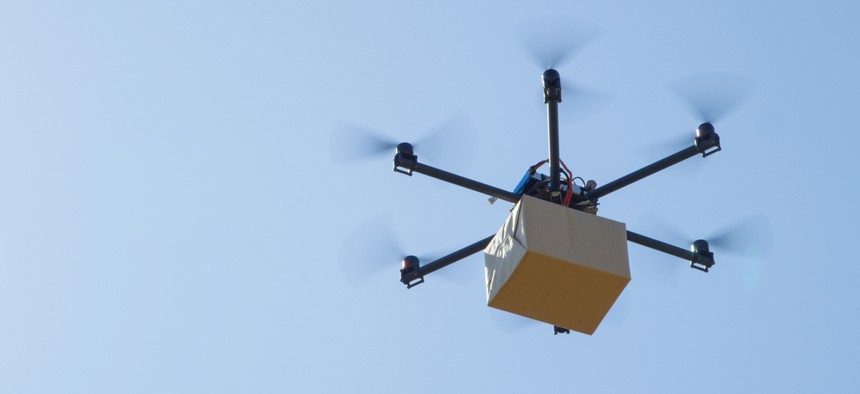The Postal Service is Exploring Big Ideas for Small Drones

Flystock/Shutterstock.com
Unmanned aircraft could transport packages across tough terrains and inform future initiatives to introduce autonomous vehicles.
The United States Postal Service recently announced it’s exploring introducing drones into its vehicle fleet to advance mail delivery operations and support its collection of geospatial, sensor, image and other data. The independent agency published a document of answers to potential participants’ questions Friday, offering new details into its plans.
“The Postal Service recognizes that the ability of [unmanned aircraft systems] to supplement mail delivery and information collection can substantially benefit the country and further the development of other autonomous systems,” agency officials wrote in the original request for information.
The Postal Service currently has no incumbent contractors fulfilling drone-related services and noted that, if implemented, this would be a first-of-its-kind program. Through the initial RFI published in late September, the agency does not aim to award a direct contract to a vendor to immediately deploy services. Instead, it’s conducting market research, to better inform the future of the postal service’s delivery operations and potentially accelerate the safe adoption of UAS technology across the nation.
The agency noted it would likely work with multiple entities to integrate drones into its fleet, and that it “may identify candidates for a future solicitation” aimed at boosting its operations and testing the viability of unmanned aircrafts to transport mail.
Regulated by Federal Aviation Administration rules, the Postal Service anticipates integrating drones to support services such as “long driveway delivery” by launching drones from vehicles to make deliveries and then return on their own as carriers continue along their routes. They could support difficult deliveries to remote places like small islands or across rugged terrains. The agency also aims to explore a “ride-sharing model,” through which customers can access an application to connect with USPS drone fleets for “business to customer” delivery options. In the future, it may also offer infrastructure as a service, which would enable drone service providers to leverage USPS tools, data and services to accomplish tasks like farm or power line inspections.
It is also considering using drone technology to capture geospatial, compressed visual and sensor data to create “three dimensional mapping for use in autonomous vehicle initiatives” and its own land and facility management efforts.
The agency is interested in operating beyond the visual line of sight and intends to run the drones for eight continuous hours a day, at a minimum. They’ll make four flights and deliveries a day on average, but may also embark on up to three deliveries during each hour they operate. The UAS may also make additional stops to collect data, as directed, and they’ll fly or hover over water, a variety of terrains, “and, eventually, over city streets.”
In the question and answer document published most recently, the Postal Service said that they initially want the unmanned system to carry packages of up to 55 pounds, which complies with current FAA regulations.
“However, the postal service is evaluating whether larger package sizes and weights may be needed to meet some objectives,” it said.
It also added that it will host an industry day to showcase key technologies, depending on the subsequent responses it gains to this RFI. Ultimately, the agency wants drone operators and developers interested in providing it with drone-led mail delivery and supporting services to weigh in on all that they have to offer.
Comments should be sent by email no later than Nov. 4.
FAA recently certified package-delivery giant UPS to operate the first-ever national drone airline system, which it will use to deliver and transport medical supplies to facilities across the country.
NEXT STORY: The Endless Aerial Surveillance of the Border






